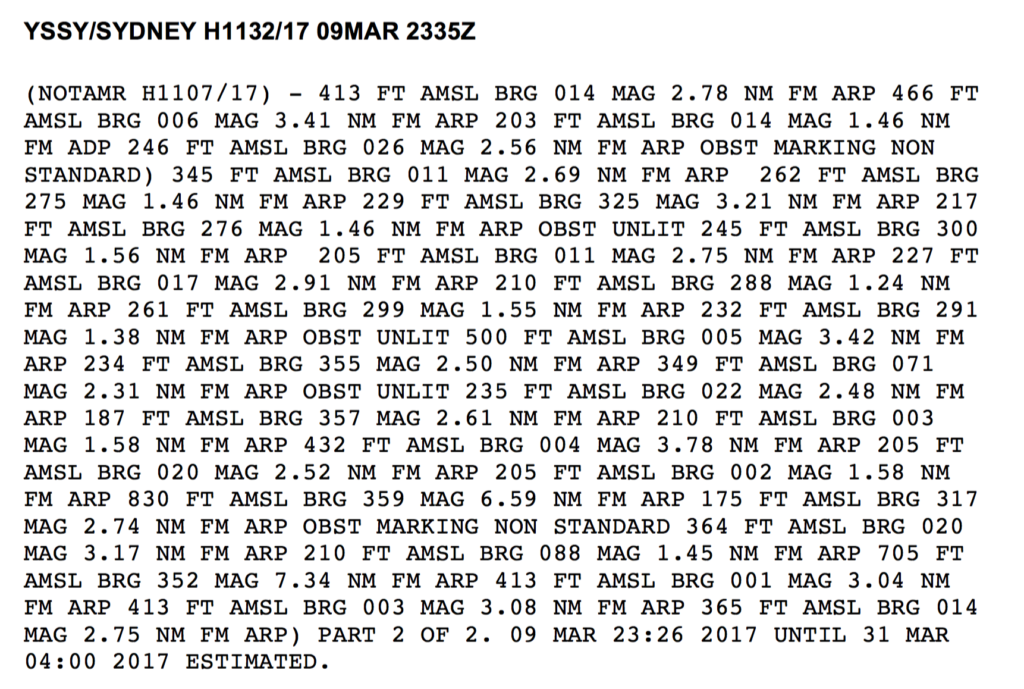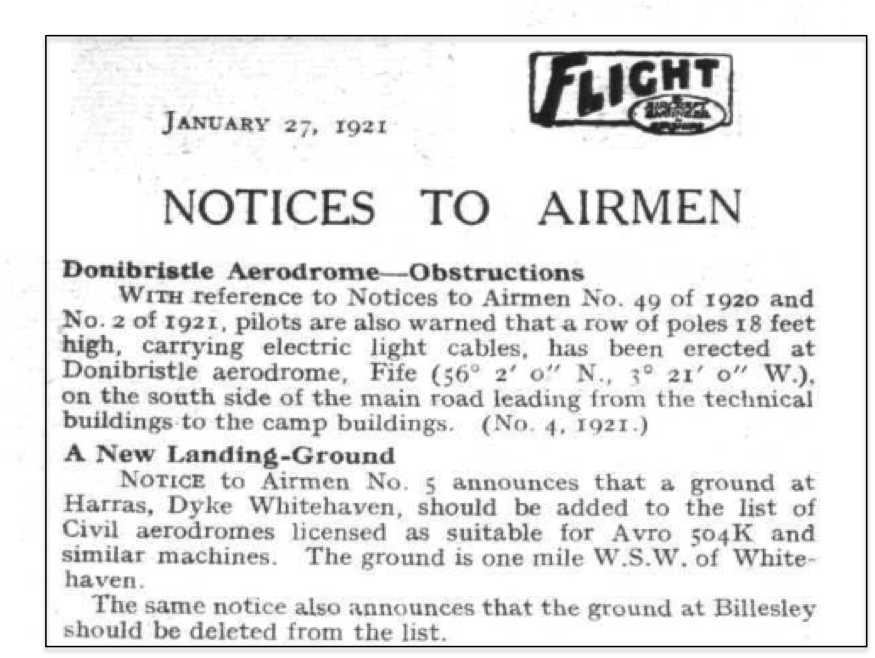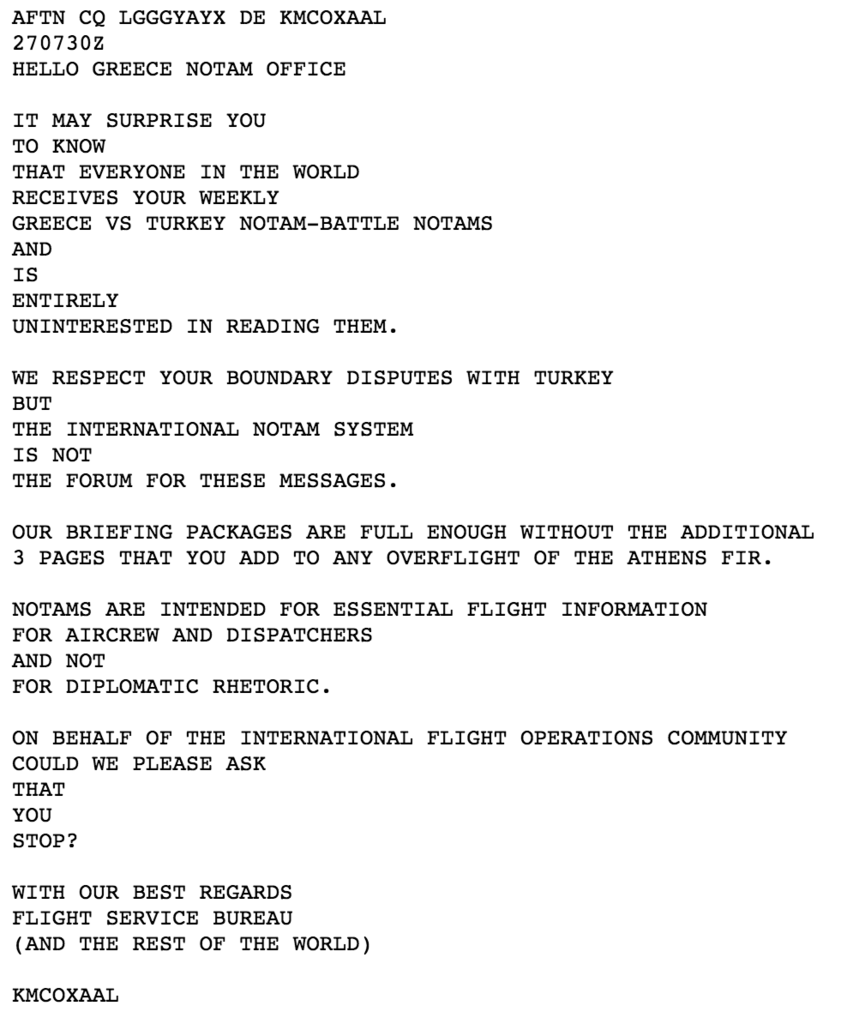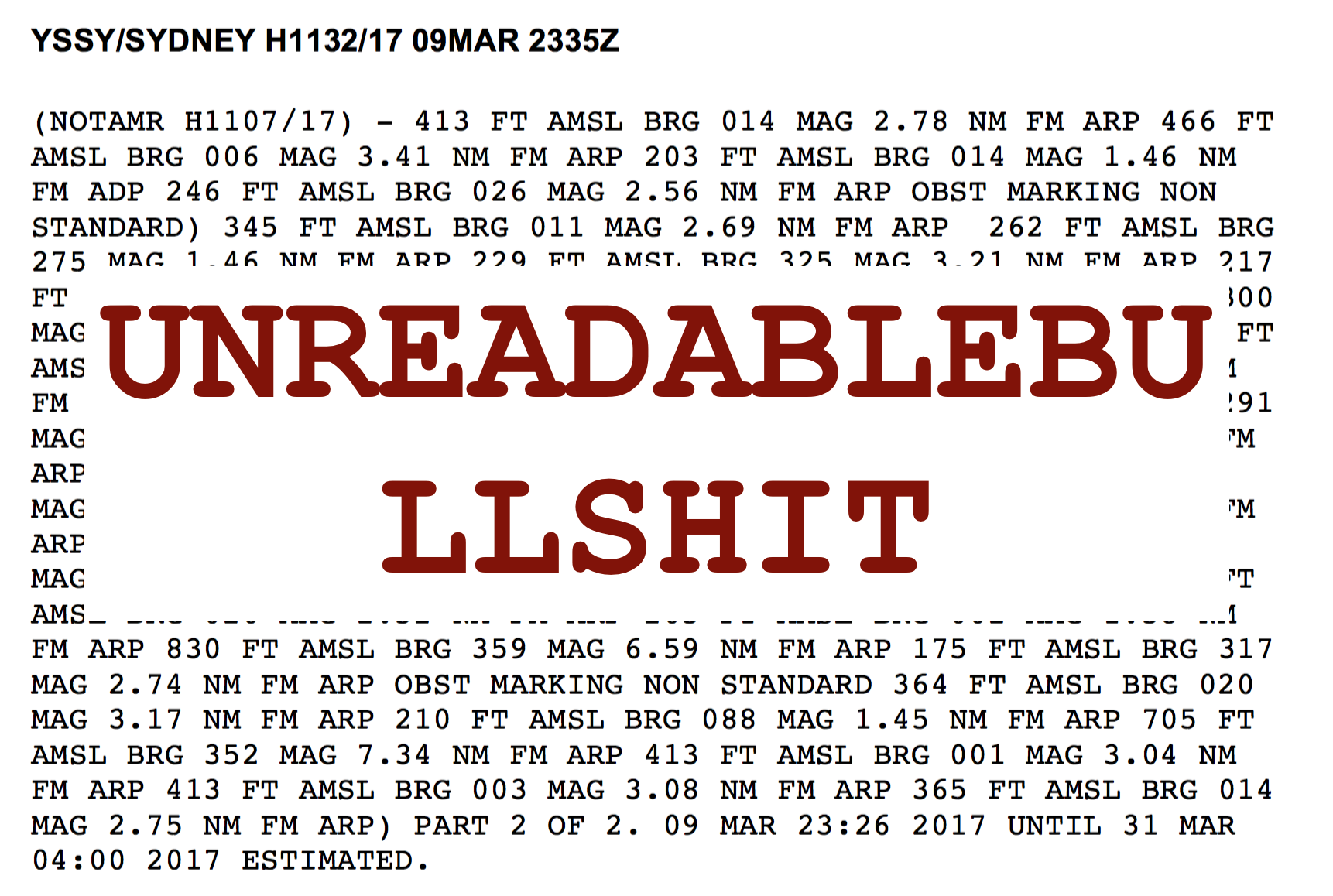Update: November 1st, 2019: The Notam Team is up and running – we’re fixing Notams. Follow our progress at fixingnotams.org.
It’s absolutely ridiculous.
We communicate the most critical flight information, using a system invented in 1920, with a format unchanged since 1924, burying essential information that will lose a pilot their job, an airline their aircraft, and passengers their lives, in a mountain of unreadable, irrelevant bullshit.
Yes CASA Australia, that’s you. Yes, Greek CAA, that’s you. And you’re not alone.

In an unintended twist of irony, the agencies seeking to cover their legal ass are party to creating the most criminal of systems – an unending flow of aeronautical sewage rendering the critical few pieces of information unfindable.
This is more than just hugely frustrating for each pilot, dispatcher, and controller that has to parse through it all; it’s downright dangerous.
If you’re a pilot, you’ll either have already experienced this, or you’re going to – you stuff something up, and then be told: “but there was a Notam out about that”. Sure enough, there it is in black and white (and in big capital letters). Do you think that “but there were 100 pages of them” is going to be a valid defence?
Well, it should be. The same agency conducting your post-incident interview is busy on the other end stuffing the system full of the garbage that prevented you from seeing it in the first place.
There are three parts to the problem: the system, the format, and the content. The system is actually quite amazing. The AFTN network connects every country in the world, and Notam information once added is immediately available to every user. Coupled with the internet, delivery is immediate.
The format is, at best, forgivable. It’s pretty awful. It’s a trip back in time to when Notams were introduced. You might think that was the 1960’s, or the 50’s. In fact, it’s 1924, when 5-bit ITA2 was introduced. The world shifted to ASCII in 1963, bringing the Upper and Lower case format that every QWERTY keyboard uses today, but we didn’t follow – nope, we’ll stick with our 1924 format, thank you.
Read that again. 1924. Back then, upper case code-infested aeronautical messages would have seemed impressive and almost reassuring in their aloofness. But there weren’t in excess of 1 million Notams per year, a milestone we passed in 2013. The 1 million milestone is remarkable in itself, but here’s something else amazing: in 2006, there were only 500,000. So in seven years, Notams doubled. Why? Are there twice as many airports in the world? No. Twice as many changes and updates? Possibly. But far more likely: the operating agencies became twice as scared about leaving things out.
And so onto the culprit: the content. The core definition of a Notam is ESSENTIAL flight information. Essential, for anyone tasked with entering information into the Notam System, is defined as “absolutely necessary; extremely important”. Here’s a game you can play at home. Take your 100 page printout of Notams, and circle that ones that you think can be defined as essential. See how many fit that bill.
So why is all this garbage in the system? Because the questions that the creators of Notams ask are flawed. The conversation goes like this:
– “Should we stick this into a Notam?”
– “Yeah, we’d better, just in case”.
How many are actually asking, “Is this essential information that aircrew need to know about ?”. Almost none. Many ‘solutions’ to the Notam deluge involve better filtering, Q codes, and smart regex’s. This overlooks the core problem. It’s not what comes out that needs to be fixed, it’s what goes in.
Even in 1921, we had much the same problem. Obstacle, 18 feet high, several miles from the runway.

Nobody cares. Unless you’ve parked the Eiffel Tower on the threshold, leave this stuff for the AIP. And nobody cares about kites either. Nor about goat-grazing times. We don’t care if your bird scarer is U/S. We don’t care if there’s a cherry-picker fixing a bulb somewhere. We don’t care when you’re cutting your grass.
Nor do we care about closed taxiways. The only way I can get onto a taxiway is with an ATC clearance, and ATC will not clear me onto a closed taxiway.
We care if the airport is going to be closed when we get there. If we’re going to have to divert because the runway is shut. If someone might shoot at us. If there are new rules. We care about the critical items, but we won’t see them as things stand.
And so, about here is where a normal editorial piece might end with “we hope that the authorities improve the system”, and sign off.
But not here.
We’re in the business of doing things here at FSB, not just talking about them.
Last year we wrote a few pieces about the Greece vs Turkey Notam battle. This month we did a group look at Briefing Packages, and it was astonishing to see how many pages of this diplomatic drivel still appeared in all our members’ Briefings. All in all, on average 3 full pages of every briefing for a flight overflying Greece or Turkey contained this stuff.
So, we sent Greece a polite AFTN message on behalf of all of us.

That’s just one piece of a thousand-piece puzzle, and it would be nice to think that one piece at a time we could fix the sytem. Let’s get real. It’s a monster, and it’s out of control.
We don’t think that we can fix the Notam system.
But, we can think about a different solution. And that’s exactly what we’re doing right now in OpsGroup. With almost 2000 members, we can make a difference. Watch this space. Or, if you want to help take action, send your thoughts to goatams@ops.group.
More on the topic:
- More: Why do we see US Military Notams?
- More: The Finish Line: NOTAM SPRINT 2023
- More: Taking the Trash Out: Let’s fix NOTAMs
- More: US Grounds All Flights After NOTAM System Failure
- More: China Airport Alternate Restrictions
More reading:
- Latest: Mexico Customs Surprises: Pills, Vapes, and Laptop Rules
- Latest: Greenland NAT Alternates: Dec 2025 Update
- Latest: Crossing the Quiet South: From Australia to Argentina
- Safe Airspace: Risk Database
- Weekly Ops Bulletin: Subscribe
- Membership plans: Why join OPSGROUP?












 Get the famous weekly
Get the famous weekly 






Frankston Vic.? Me too and 25,000 hours later, I couldn’t agree more , and i don’t even need rough language. I still struggle with date/time groups which have to be read backwards- unless I select an option from our provider which puts it into plain every day dates and time. it can be done.
I agree – like much of the plethora of information we are bombarded with, there may gems hidden among the desert landscape of irrelevant notams. For example, the one that has been there for years about an unlit obstacle a few miles north of the ARP at Kalgoorile. If I’m flying into Kal (on a 330 that is unlikely) and I’m a few hundred feet off the ground at night then hoping I’m going to see the obstacle even if it was lit, is not a strategy that will ensure my survival! So whether or not that obstacle is lit is not of much interest to me, nor is the status of Tasman sea military airspace when I’m flying between Perth and Melbourne. I wouldn’t have enough fuel to even get to the Tasman sea!
While I understand some of these thimgs may be required viewing regardless of their relevance, others are simply swarf and detritus – rubbish information that obscures by its volume, more important information. The greater the amount of information we are provided, the more likely it is that we miss the important stuff. If one day an incident arises due to somebody not knowing something which is present somewhere in one of the thousands of pages of company provided information, I think it would not be hard to prove to a fair-minded judge that the volume of information could not be absorbed and known fully. In particular, with an hour to preflight, including many things as well as perusing notams, it could easily be shown that even if written in plain language there might not be time to fully and accurately read, understand, and remember every piece of information before flight. Most of us are conscientious enough to meet our obligations to know things by reading it before we actually sign on, but the system does not really allow enough time in some cases, given the sheer volume of info provided. One other type of notam is in relation to icing areas, usually described using lat and long coordinates. Does anyone have time to take these and plot them? Many of the areas given are so far away from the flight plan track that you could not ever be able to fly into them.
just my thoughts, great topic. I see by the word used (BS) why I got an email warning me that someone at yammer was sending me messages using “inappropriate“ language – I grew up in Frankston, so there is no language that I find “inappropriate”.
In Romania we implemented a software solution that deciphers all the METAR, TAF, SIGMET etc. messages as to be more easy to transmit, specially for VFR pilots. All is done into plain professional English language. Why not possible to use it also for Notams?
95% of Notam’s we read are not applicable, or nothing can be done about them. Oh great, I’ll pull out my chart and plot the 25 co-ordinates to see if this airspace will affect my flight -_- that’s one Notam example from plenty of the same type, in the same Notam briefing. Now add the other irrelevant Notam types as mentioned by others in the comments.
What a joke.
I totally agree with you. NOTAMs should be useful for the reader, not for the writer.
Capital letters slow down the scanning speed by a third. Nobody would read a newspaper written in capital letters. Why should we pilots?
Finally, I propose the abolition of the silly NOTAM: “MEN AND EQUIPMENT ON BOTH SIDES OF THE RUNWAY – LANDING WITH CAUTION”
If you don’t write it down in capital letters how am I suppose to land, without caution?
Well written. After we’ve fought this battle, can we then start anotger one on the ATIS that in many places is thrown at you at the speed of light by a voice that is tripping over it’s own tongue? Anno 2017 there are easier ways to do it like in Spain.
Another piece of essential information that has eroded to something unusable in many airports.
I have come up with a name for this problem: “NOTAM Spam”. It’s a serious one, alright — ASRS Callback #426 brought it up in the context of the US NAS, and I’m sure it’s only worse for international operations. It sounds like ICAO needs to put out a recommendation or SARP about NOTAM spam control…
Now, you are talking, man!
About two days before I saw this post, I’d sent a long email to my company telling them of the NOTAMs we don’t need to see. Then I saw this. Brilliant! I’ve just sent the link to this piece to the company to reinforce that opinion. I’m hoping our briefing pack will be several pages thinner the next time I go to dispatch.
Excellent article.
Excellent analysis. My personal favorite is the NOTAM sort order which tells me that the REIL lights don’t work, the glideslope is out, the runway markings are non-standard, the localizer is out… ending with: runway closed. Tell me that first, all the other BS becomes irrelevant.
There are interesting Apps, like AeroWather or AeroNotams where you can set filters, you’ll see how many of them you can skip!
You’re hitting the nail on the head guys. ?
How about a change in the format of NOTAMS too, so we don’t have to wade through the whole lot in order to parse the relevant information. NOTAMS are removed when thy are no longer valid, so why cling to chronological order as an indexing system.
How about putting them in order of critical relevance:
Firstly, changes to airfield opening hours and services (fire, fuel etc). Secondly, changes to runway lengths/closures/etc. Thirdly, changes to approaches available.
All the rest can be thrown into the mix at the end of the NOTAM.
Yes we can!
And don’t forget about TFR’s that pop up. The one time I didn’t look at TFRs I got trapped having to divert from Chicago to an outlying airport even though we were part135 and even though we got an IFR clearance and the tower gave us takeoff permission. And center control for an hour just kept passing us on.
Thank you for this essential initiative!
Perfect…..
We train the pilots of tomorrow, they are inundated with everything the industry throws at them and the unintelligible Nonsense contained in some NOTAMS are just another accident waiting to happen. With all the technology at our disposal today, the filtering systems, electronics messages systems, integration tools and smart people to think about it, there is a solution out there.
I suppose we just need to make enough noise in the right places to make a change. Oh well best we get started. hmmm, perhaps a NOTAM about change is needed.
Yes… and why oh why are we still using the coded TAF language. We don’t have bandwidth issues anymore. We take plain English, code it, then decode it back to plain English. Surely a TAF written in plain English is not too hard a transition.
What is clear is the professional approach to the information received: too many inputs, disorderly given, contextually irrilevant, redundant and unusable.
A kind of “cry wolf” syndrome, making the pilot complacent about such a bullshit.
The very day someone of us is caught in a legal battle for a system-induced mistake leading to a incident, overlooking the NOTAMs will not appear as an excuse.
How to make these information valuable?
I absolutely agree. My personal bugbear is those lists of co-ordinates …. do they think anyone actually plots them on a map? They might as well not be published at all.
Well said.
Have you ever read “MEN AND EQUIPMENT NEAR THE RUNWAY: LANDING WITH CAUTION”?
So, If you don’t tell me that, I will land recklessly..
you can bet your life, the one you needed to see at 3 in the morning was the one you missed! Any wonder..
How many pilots out there actually read ever Head Office Notams or even daily Notams in meticulous detail? Few (if any). You sign on an hour before departure, there is simply not enough time to divulge all the ass covering crap that’s generated daily. Airline companies only want one thing, OTP; how a pilot goes about that they couldn’t care less as long as you don’t break any rules!
NOTAMS = “None Other Than Aircraft Missing Slots”
You are a mind reader.
You captured the issue perfectly and the historical context was excellent. While airspace and aircraft have all continued to develop our most basic system of communicating the status of an airport/airspace has not. I could take that further and say communication with ATC is still by AFTN for the most part.
So now put yourself in the position of dispatcher/FOO working a series of long haul ETOPS Flight. You might have 20 or more departure /Take off alternate station notams, a whole galaxy of FIR/UIR Notams, not to mention all of the ETOP alternates and if you re-dispatch/re-analysis, you will get to do it inflight once again. Now do that 15-20 times depending on workload.
Can you say human data saturation?
This article certainly illustrates the infrastructure issues we face, but it doesn’t come close explaining some of the processes and procedures we have had to put in place to ensure:
1. That we actually get NOTAMS.
2. That we get airport conditions as some countries don’t put them out as Series-S ICAO NOTAM versus Series-A (Yes, theses are the countries that haven’t fully adopted ICAO standards which were adopted in 1944 and ratified in 1947 by the Chicago convention).
Question: What is the current year?
This information ceased to be “NOTAMs” long ago. Today they are “NOTOLs”, Notice To Litigants. Thanks for making an effort to change this ancient system.
Congratulations, its our industry, the users should be heard.
Start with a blank sheet of paper, what do we want to know in a “NOTAM” and how best to communicate it in a cockpit / in a flight briefing package. If the current format was frozen in 1924, the next system needs to be good for a couple of years.
This.
I would’ve busted an important no-fly zone for that exact reason on one occasion. Luckily, Flight Following and very helpful controllers saved me.
A potential way to combat this (and cover your ass at the same time): File a report using the voluntary reporting system in your area, e.g. http://www.aviationreporting.eu/ .
B.S. NOTAMS….100% concur. Our whole world of aviation is being swamped by similar legal ass-covering paperwork. How can ANY pilot be expected to remember all the additional codicils that do NOTHING to improve safety of flight, but rather give an army of lawyers and providers more chances to fleece an already cash-strapped industry?…..Rant over!